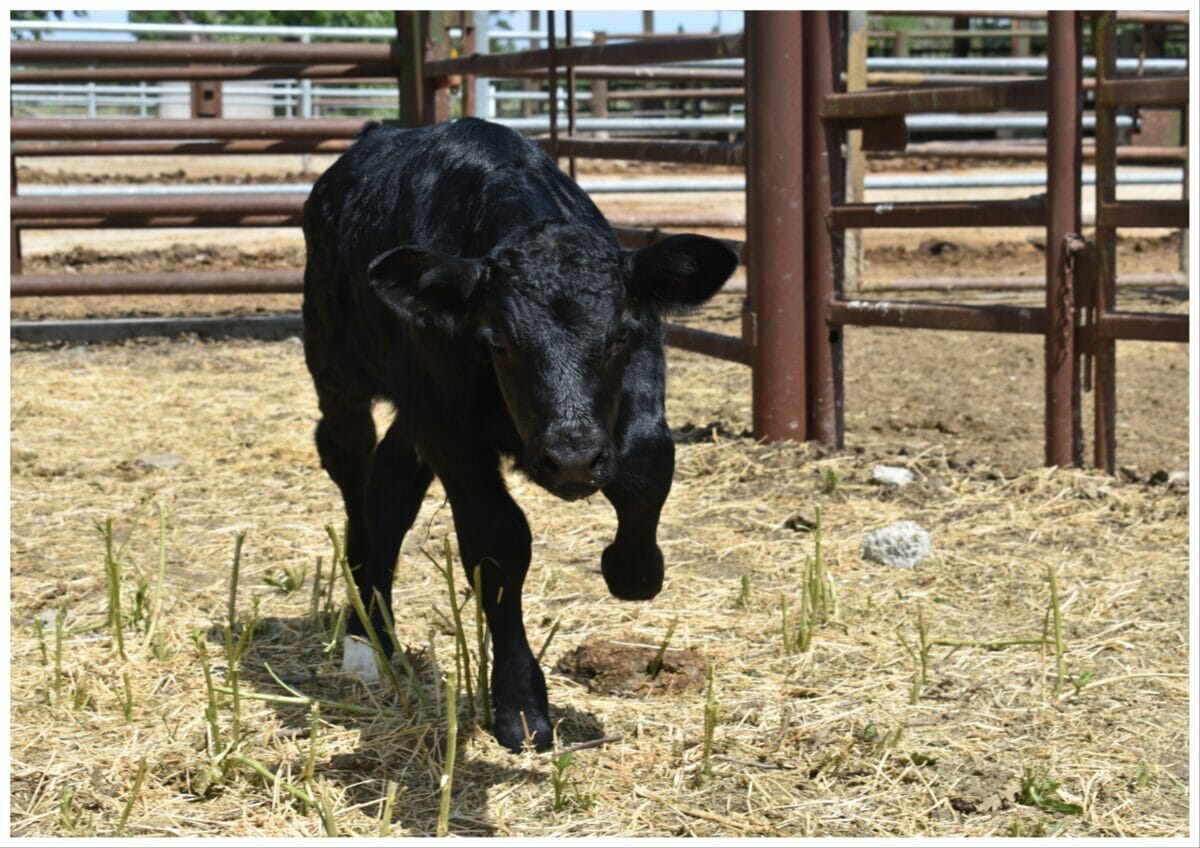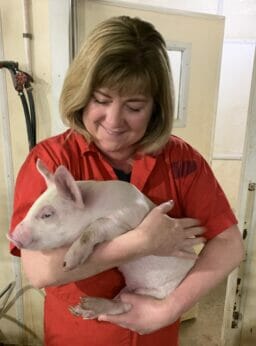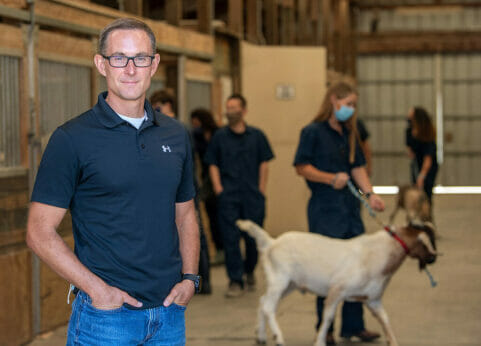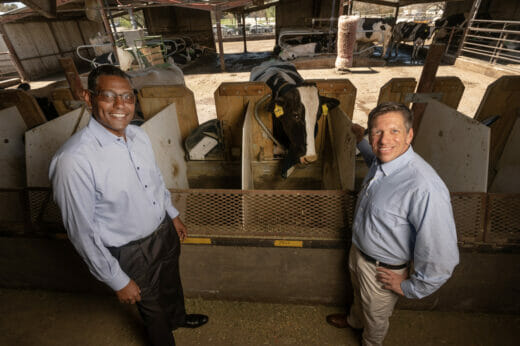Researchers are learning just what’s possible using the gene-editing technology CRISPR, which advocates say can prevent disease, improve food security and reduce methane emissions.

Alison Van Eenennaam, a professor at the University of California, Davis, has a few very pregnant patients to look after this fall and into the new year. These patients require some extra care, as they’re carrying experimental fetuses.
Van Eenennaam, a professor of animal biotechnology, implanted embryos this spring in a herd of cattle, which carry the SRY gene. The fetuses—all female—will develop male characteristics, growing beefier and faster than females without the gene, something that would benefit cattle producers, says Van Eenennaam, who runs the Animal Genomics and Biotechnology Laboratory at UC Davis.
The embryos were created from the semen of a bull named Cosmo. The SRY gene he passed on wasn’t developed through classic selective breeding, however, but a technology seemingly appropriated from science fiction—CRISPR/Ca9. The technology accelerates trait development by facilitating the precise deletion, insertion or modification of genes. It can also “turn off” or inactivate genes that make animals susceptible to some diseases, says Van Eenennaam. By inserting the SRY gene into chromosome 17 when Cosmo was an early-stage embryo, the gene became something he now passes on to all offspring, no matter the sex.

Alison Van Eenennaam with Cosmo. (Photo courtesy UC Davis)
The technology received the Nobel Prize in Chemistry 2020, igniting a flurry of research as scientists explored its potential to change plant and animal DNA. With a growing global population of eight billion and the demand for animal protein soaring, new technologies are needed to make agriculture more efficient while reducing its enormous environmental impact. CRISPR promises a genetic revolution, with advocates hopeful that it can address disease prevention, food security and a reduction of methane, the greenhouse gas spewed by ruminants that is 25 times more potent than carbon dioxide at trapping atmospheric heat.
The only limit to CRISPR’s abilities, it seems, could be scientists’ imaginations.
Editing out disease
There is a deadly virus that causes porcine reproductive and respiratory syndrome (PRRS), which afflicts pigs worldwide, reducing growth in young swine and causing late-term abortions and stillborn piglets in sows. The disease costs the American pork industry more than $650 million a year; in Europe, €1.5 billion is lost annually to the virus.
The global biotechnology company, Genus PIC, has used CRISPR to remove a portion of the gene that causes PRRS. “A PRRS outbreak can wipe out an operation,” says Elena Rice, chief science officer at Genus. When pig farmers hear about CRISPR providing a “solution to the disease,” says Rice, “their first words are: ‘Give it to me tomorrow.’ I need it, I want it.’”

Elena Rice is chief science officer at Genus, a biotech company developing disease immunity via CRISPR. (Photo courtesy Genus)
Genus has produced four generations of pigs with immunity to PRRS, showing “the stability of the gene being inherited,” says Mark Cigan, Genus’s trait development director. Now, Genus has a population of animals with CRISPR-created immunity. The goal for companies like Genus is to breed these animals and allow their enhanced genes to spread into the wider pig population. This has yet to happen, however, as the Food and Drug Administration (FDA) hasn’t approved animals with this CRISPR edit.
Rice says that Genus has been working closely with the FDA for years and “hopes to obtain approval in 2024 for CRISPR-edited animals with PRRS immunity.” Regulatory approval is critical, says Rice, as other countries look to the FDA to “guide their decision-making on gene editing.”
The FDA is cautious, however, about CRISPR gene edits in animals, something it labels intentional genomic alteration, or IGA.
Adam Moyer, acting director, division of animal bioengineering and cellular therapies at the FDA’s Center for Veterinary Medicine (CVM), says that IGA analysis includes determining whether it causes “unintended alterations, like mutations.” One example, says Moyer, was pigs where two genes were removed via CRISPR, making them immune to PRRS as well as the transmissible gastroenteritis virus. The pigs were not only resistant to the viruses but showed “increased iron content in the muscles, indicating that the composition of the food derived from such animals would’ve been unexpectedly altered,” says Moyer. This, he says, is an example of “unintended implications that could impact animal or food safety.”
Cigan says Genus has done extensive studies on the pigs that have undergone CRISPR editing to prevent PRRS viral infection and cleared them of any unexpected genetic or meat composition changes. “The pigs look great,” he says.
The FDA, despite its prudence, is enthusiastic about CRISPR’s “great promise,” says Moyer. It granted food use authorization this year for the five pigs involved in a CRISPR project from Washington State University that produced data showing no harm would come from consuming gene-edited swine. To celebrate, WSU hosted a barbecue with sausages made from the pigs.

Jon Oatley and research team on the campus of WSU in 2020. (Photo courtesy Washington State University)
What makes CRISPR notable is that the genetic changes it creates are inherited by offspring, just like traits that are developed through selective breeding. CRISPER edits make a “significant change in one generation,” says Dr. Jon Oatley, a reproductive biologist who is undertaking CRISPR research at Washington State University School of Molecular Biosciences. This contrasts with “selective breeding, [which] takes five to 10 generations to make an incremental change,” says Oatley.
The five swine possessing a CRISPR edit were created at WSU as part of a project called “surrogate sires,” says Oatley. He used CRISPR to remove the NANOS2 fertility gene in the pig embryos, which caused the males to be born sterile. The young swine’s testes were then injected with sperm-producing stem cells from “high-value” pigs, turning these unremarkable animals into elite breeder males. This process gives breeders around the world “access to genetics that they would never have been able to get access to before… creating hundreds of males that all produce sperm from the elite male,” says Oatley. The final tally to obtain approval from the FDA for the CRISPR-edited pigs was $200,000. This included two years of feed and labour costs and extensive data collection, including expensive molecular analysis, says Oatley. “We needed to show that there [weren’t] any changes in their DNA due to CRISPR that we didn’t expect.”
Gas be gone
CRISPR technology may prove most useful when it comes to a more widespread issue: mitigating the methane-infused burps and farts caused by ruminant gut microbes that contribute to atmospheric heating. In the US, livestock produce about one-third of all methane, says Ermias Kebreab, director of the World Food Center at UC Davis.
Kebreab and UC Davis associate professor Matthias Hess are part of a new initiative aiming to reduce greenhouse emissions by engineering the microbiome in cows and other ruminants. The research will analyze the microbes in bovine digestive systems, “[identifying] microbes and genes we want to target for editing,” says Hess. He isn’t looking for the complete elimination of methane, since it is “metabolically very important for an animal.” A reduction of 60 to 70 percent would be a huge accomplishment,” he says.

Ermias Kebreab and Matthias Hess stand together in the cow dairy facilities on April 10, 2023. They won the TED Audacious award with UC Berkeley and UCSF for their work with dairy cows. (Photo courtesy UC Davis)
Neither Hess nor Kebreab are certain at this early juncture whether a change to the microbiome will be inherited by offspring. However, mothers normally pass down their microbiome to their calves, and Kabreab anticipates that this will happen with CRISPR-edited microbes.
The biggest challenge to obtaining buy-in for CRISPR may come not from regulatory agencies such as the FDA but from ordinary farmers and consumers. Bioethical issues have been raised about CRISPR gene editing in animals, with most of the concern centered around unintended effects on meat quality, as well as animal welfare. Older farmers have been the most vocal, says Oatley. Some have accused him of “playing God” and admonished him to “stop trying to do things nature didn’t intend.” Younger farmers “just love it. They’re asking me, ‘when is it going to be available for me to use?’”
Cigan adds that the final word may ultimately fall to consumers, who must collectively be convinced of the safety of the technology once CRISPR-edited products are approved for the marketplace.
Will the meat be required to be labeled as genetically altered when sold for consumption?
This is going to have bad consequences, just as the Covid virus shots had bad consequences. These people are messing with things far beyond their understanding. Declaring themselves to be wise they became fools…. I do not care to be dragged down their foolish path unawares.
“…..engineering the microbiome in cows and other ruminants. ” This is insanity. Cows are the most amazing digestive beings and create the most amazing fertilizer that can be. Their stomachs are beautifully designed and perfect as they are – who do we think we are, recreating creation?